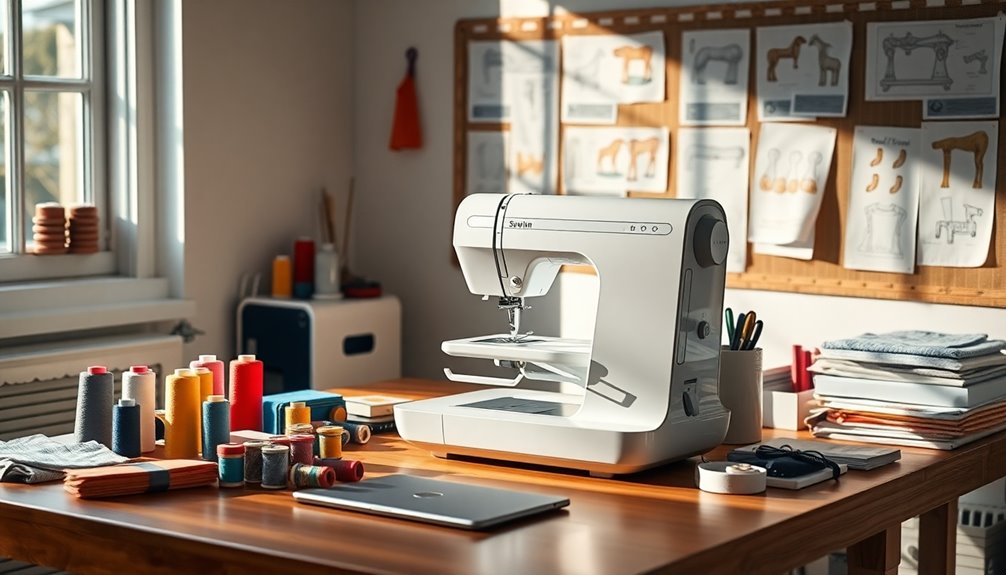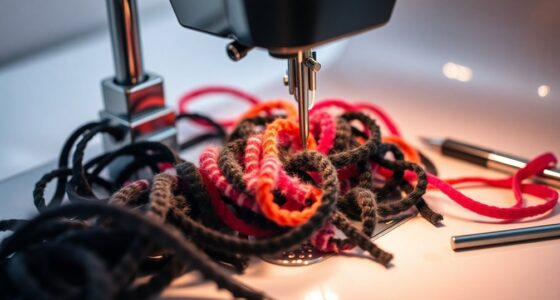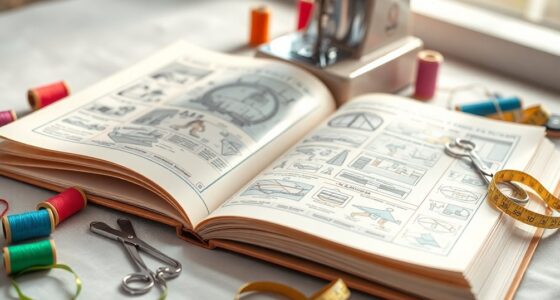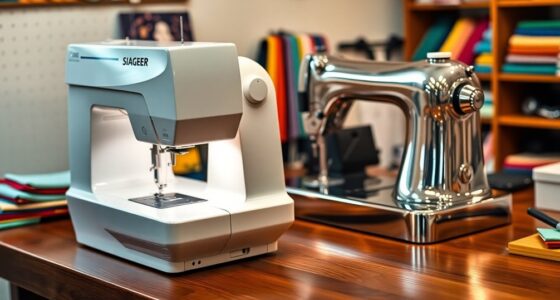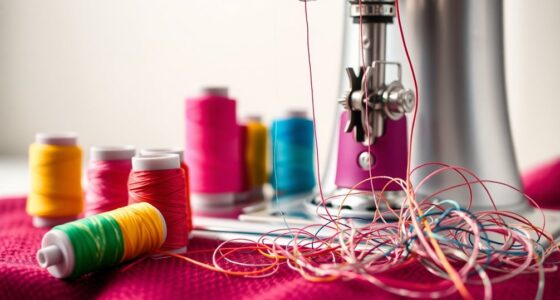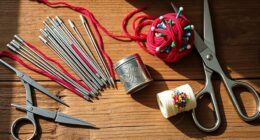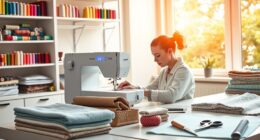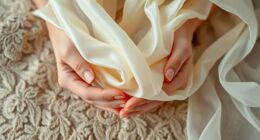To choose the right sewing machine for your home, start by evaluating your sewing needs and experience level. Set a budget that balances quality and essential features, like stitch options and adaptability to various fabrics. Understand the different types of machines available, from basic mechanical to advanced computerized ones. Finally, test machines hands-on to find the best fit for your projects. Keep going to discover more about brand recommendations and shopping tips!
Key Takeaways
- Assess your sewing frequency and project types to determine the features and durability needed in a sewing machine.
- Set a budget that balances quality and cost, keeping in mind additional expenses for accessories and maintenance.
- Look for essential features like stitch variety, adjustable settings, and capabilities to handle different fabric types.
- Understand the differences between mechanical, electronic, and computerized machines to choose one that matches your skill level and projects.
- Test machines hands-on to evaluate usability, comfort, and growth potential for future sewing endeavors.
Assessing Your Sewing Needs and Experience
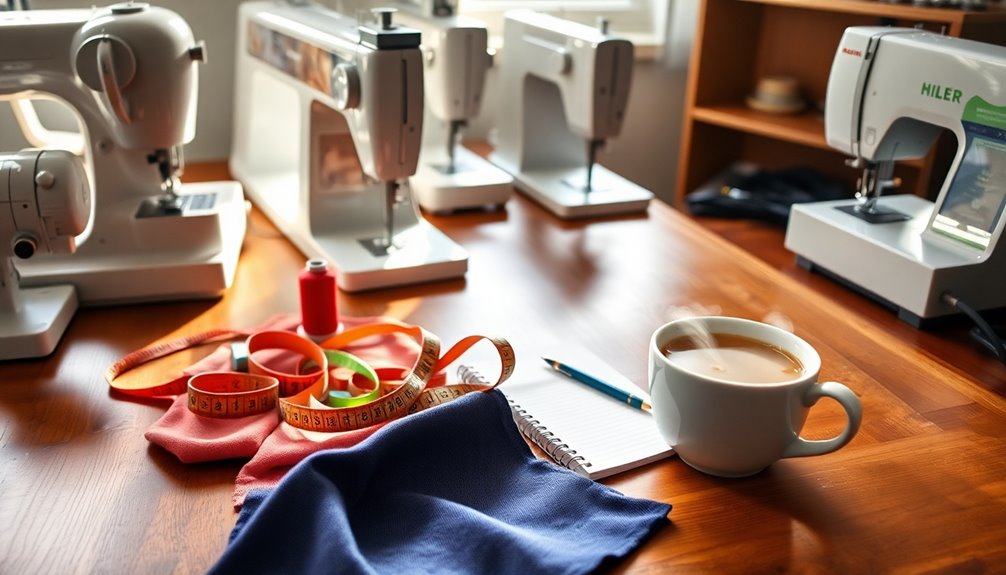
How often do you plan to sew, and what kinds of projects are you interested in?
To choose the right sewing machine, you need to assess your experience and future projects. If you're just starting with basic sewing, a starter machine may suffice.
However, if you aim to tackle a variety of fabric types, including lightweight and heavy materials, you'll need a machine with more durable requirements and advanced features.
Consider the stitch options you'll need for your projects and create a prioritized list of essential features.
This way, you can streamline your decision-making process and find a sewing machine that meets your needs effectively, whether it's for one-time use or an ongoing hobby.
Setting a Budget for Your Sewing Machine
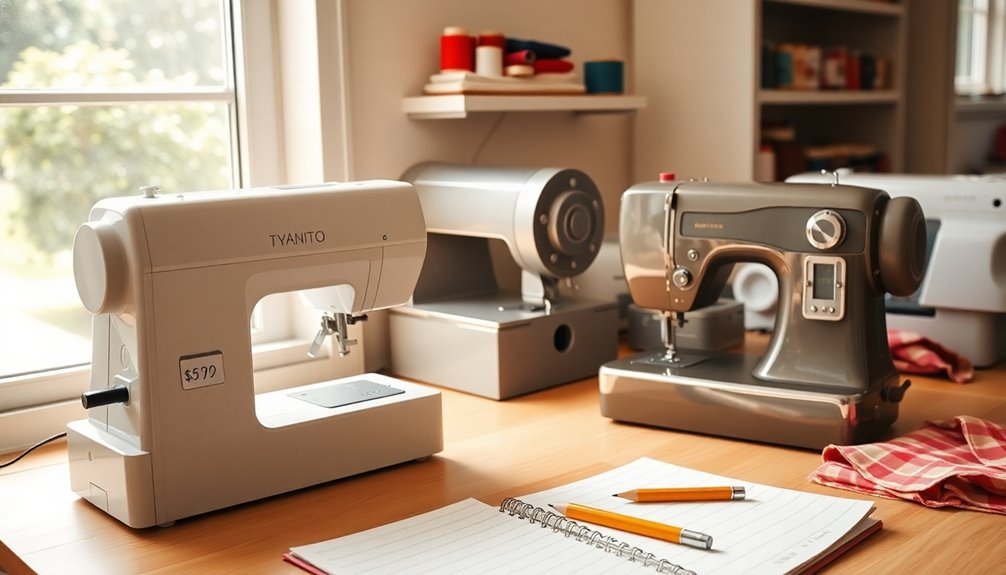
Setting a budget for your sewing machine is essential, as prices can range from about $50 for basic models to over $15,000 for high-end machines.
Start by determining your essential features to avoid overspending on unnecessary capabilities. While inexpensive models may seem appealing, investing in a quality machine can save you money in the long run by reducing the need for frequent replacements.
Don't forget to factor in additional costs like sewing accessories, fabric, and maintenance services when setting your budget.
Research local dealerships for potential financing options or payment plans to help accommodate your needs. This way, you can find a sewing machine that fits your budget and meets your sewing requirements effectively.
Key Features to Look For in a Sewing Machine

When you're choosing a sewing machine, it's vital to contemplate the key features that will enhance your sewing experience and meet your project needs.
Look for a machine with a variety of important stitch options, including straight stitch, zigzag, and at least one automatic buttonhole function for different sewing projects. Make sure it has adjustable stitch length and width settings, providing flexibility.
A needle down feature is critical for better control when pivoting fabric, making it easier to handle corners. Consider a free arm design for sewing sleeves and cuffs effortlessly.
Finally, verify that the machine can handle various fabric types, from lightweight cottons to heavier materials, confirming it suits all your sewing endeavors.
Understanding Different Types of Sewing Machines
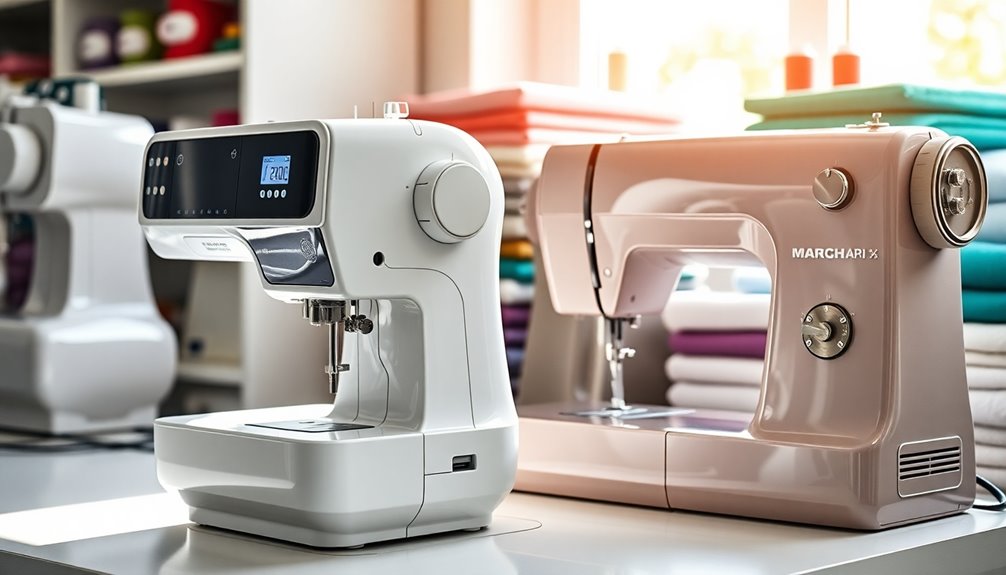
Which type of sewing machine is best for your needs? Understanding the various types can help you make an informed decision: When choosing the right sewing machine for your needs, consider the projects you plan to tackle. For general sewing tasks, a versatile sewing machine might suffice, while quilters may prefer a machine with specialized features. Additionally, understanding when to use a serger can enhance your sewing experience by allowing you to achieve professional finishes and faster hemming on various fabrics.
- Mechanical machines: Basic and inexpensive, great for beginners and simple projects.
- Electronic machines: Offer automatic features and LCD screens, perfect for intermediate sewists.
- Computerized sewing machines: Provide advanced capabilities for precision in complex projects.
When you consider buying, think about the type of sewing and the specific projects you'll tackle.
Mechanical machines are excellent for alterations, while electronic machines offer a balance of functionality.
If you're into quilting or embroidery, specialty sewing machines can be essential.
Evaluate your needs to find the perfect match that enhances your sewing experience.
Shopping Locations and Support Options
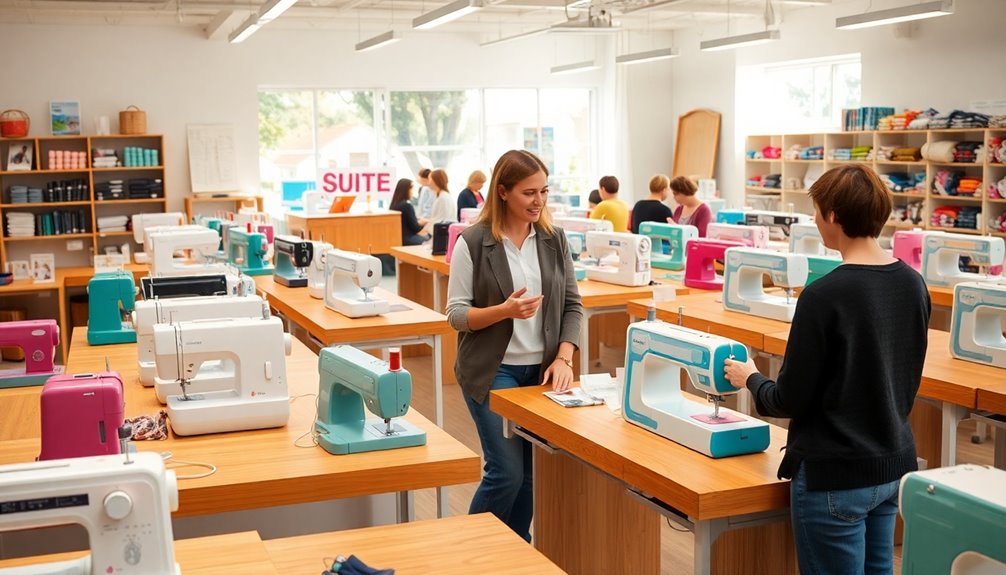
Finding the right sewing machine is just the beginning; knowing where to shop and the support available can greatly enhance your experience.
Local dealerships often provide personalized support, allowing you to test machines in-store while receiving expert advice tailored to your needs. You might also consider purchasing used machines from estate sales or thrift shops for budget-friendly options.
While online shopping offers convenience, prioritizing local sources guarantees better accessibility for maintenance and servicing. Many sewing machine dealers offer classes with purchase, helping you learn features and enhance your skills.
Building relationships with local shops aids in immediate support and fosters long-term assistance for repairs and upgrades, making your sewing journey smoother and more enjoyable.
Tips for Testing and Selecting the Right Machine
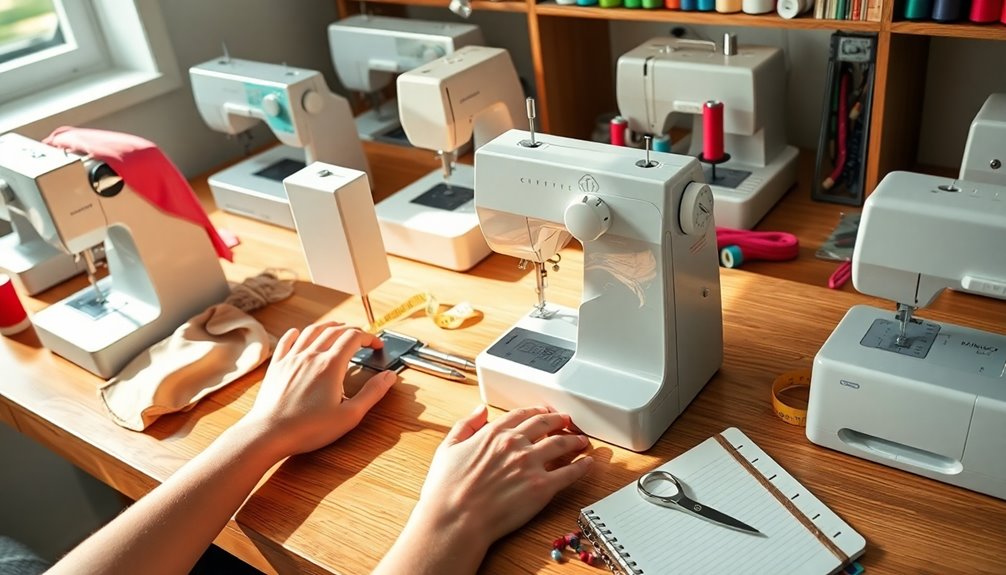
When you're choosing a sewing machine, hands-on testing is vital.
Bring your fabric swatches to assess how well the machine handles them and check essential features for comfort and usability.
Don't forget to take into account the machine's noise level and visibility of the sewing area to enhance your overall experience.
Hands-On Testing
Testing a sewing machine hands-on is essential to verify it fits your needs and preferences. Here are some key aspects to focus on during your testing:
- Ease of threading and bobbin winding: A smooth setup makes for successful sewing.
- Stitch options: Experiment with different stitches to see how well the machine handles various fabrics.
- Weight and portability: Check if it's comfortable to lift and carry, especially if you plan to move it around.
Also, assess the controls and settings for accessibility, and try the speed control to confirm it suits your style.
Pay attention to the noise level; a quieter machine contributes to a pleasant sewing environment. Your home decor projects deserve the best tools!
Essential Features Checklist
A solid checklist of essential features can make all the difference in selecting the right sewing machine for your home projects.
Start by confirming the machine offers a variety of stitches, including straight, zigzag, and buttonhole options. Look for adjustable stitch length and width, with at least four settings each, to tackle different fabric types.
Features like a needle down function and integrated free arm enhance control, making it easier to sew corners and cuffs. Additionally, check the machine's capability to handle various fabric weights, from lightweight cottons to heavy denim, for versatile projects.
Finally, prioritize ease of use with a top-load bobbin and built-in needle threader to guarantee a smooth sewing experience right from the start.
Comfort and Usability
Choosing the right sewing machine involves more than just examining features; comfort and usability play essential roles in your sewing experience. Here are some tips to reflect on:
- Check the ergonomic positioning of controls to guarantee they're comfortable for your hands.
- Assess the weight and portability, especially if you'll transport the machine to classes.
- Listen for the noise level; quieter machines can make sewing more enjoyable.
When you sit at the machine, evaluate the height of the sewing bed to prevent strain during extended use.
Also, look for user-friendly threading and bobbin winding systems, as these enhance usability, especially for beginners.
Prioritizing these factors will help you find a machine that feels right for you.
Brand Recommendations for Various Skill Levels
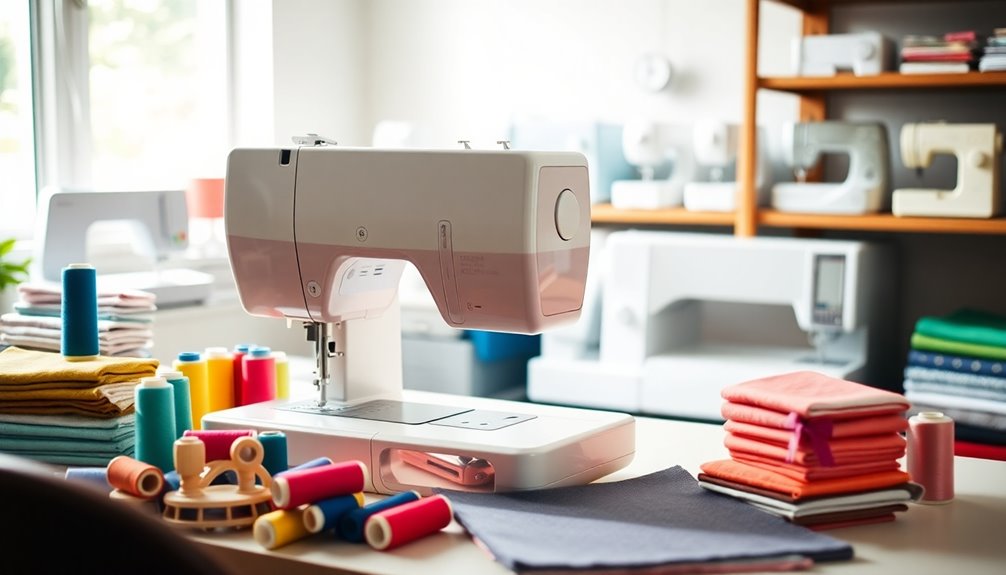
When it comes to selecting a sewing machine, the right brand can make all the difference in your sewing experience, regardless of your skill level.
For beginners, the Eversewn Maker 100 is a reliable choice, offering simplicity and solid performance.
If you're looking for versatility, the Janome Magnolia 7318 provides user-friendly features that cater to various projects.
For those ready to advance, the BERNINA 300 Series machines are known for their durability and high-quality stitching, ideal for quilting and garment making.
The Bernette B38 is also impressive, suitable for both beginners and experienced sewists alike.
Finally, if you need power to handle thick materials, consider the Viking 116 for consistent performance and reliability.
Preparing for Your Sewing Machine Purchase
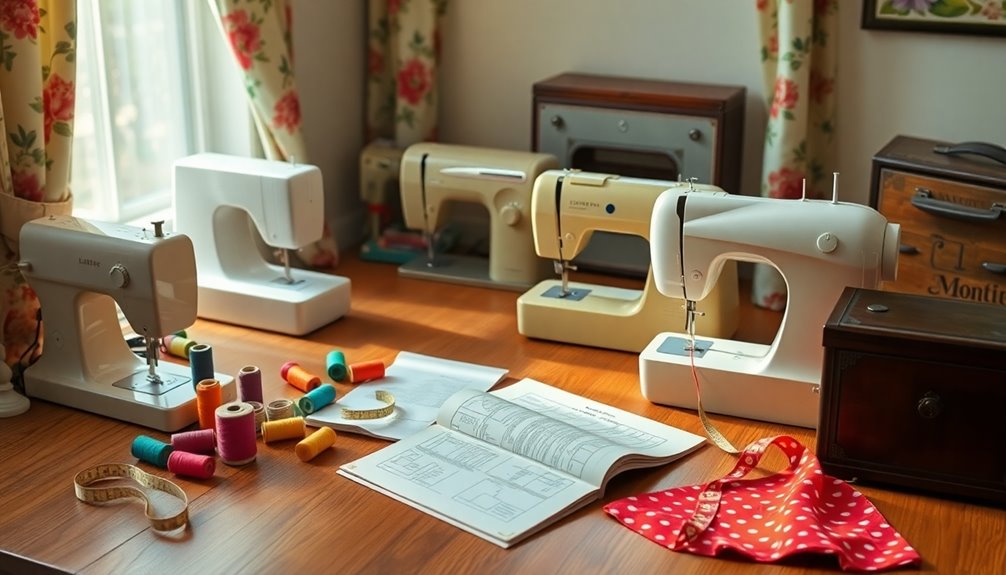
Having identified the right brand for your skill level, it's time to focus on what you need for your sewing journey.
Start by evaluating your sewing projects—are you making clothing, quilts, or home decor? This helps in selecting a sewing machine with the necessary features.
- Establish a realistic budget that balances quality and cost.
- Create a wish list of essential features, like adjustable stitch lengths and buttonhole capabilities.
- Plan for hands-on testing at local dealerships to find what feels comfortable.
Consider your growth potential; choose a machine that can evolve with your skills, whether it's a simple mechanical machine or a feature-rich electronic model.
This foundation will set you up for success in your sewing endeavors.
Frequently Asked Questions
How Do I Choose a Sewing Machine for My House?
To choose a sewing machine for your house, start by evaluating your sewing needs.
Think about the projects you'll tackle, like clothing or quilting. Set a budget that fits your finances, since prices vary widely.
Look for essential features like adjustable stitch length and a free arm for cuffs. Test machines in local shops to find one that feels comfortable.
Pay attention to durability, ensuring it handles different fabrics well.
Which Sewing Machine Has the Least Problems for Beginners?
When you're starting your sewing journey, finding a reliable machine is like searching for a trusty compass in uncharted waters.
Mechanical sewing machines, such as the Janome Magnolia 7318 and Bernette B35, often come highly recommended for beginners due to their straightforward designs and fewer complications.
These models offer basic stitch options and handy features, making it easier for you to avoid common pitfalls and enjoy your creative endeavors without frustration.
What Are Two Factors That Must Be Considered When Selecting a Sewing Machine?
When selecting a sewing machine, you've got to take into account your intended projects and your budget.
Think about whether you'll be tackling basic tasks like hemming or diving into quilting. This choice will help you determine the features you need.
Then, set a budget range, since machines can vary greatly in price. Balancing these factors guarantees you pick a machine that fits your skills and project goals without breaking the bank.
What Is One of the First Things You Should Consider When Purchasing a Sewing Machine?
Before you plunge into the world of sewing machines, think of it like choosing a smartphone—one of the first things you should consider is your primary purpose for sewing.
Are you tackling a one-time project or planning to make it a lifelong hobby? This decision influences the type of machine you'll need.
Knowing your goals early on helps narrow down your options and makes the shopping experience much easier.
Conclusion
Now that you know how to choose the perfect sewing machine, imagine this: you find a sleek, user-friendly model that fits your budget and has all the features you need. Picture yourself effortlessly stitching a beautiful quilt, transforming fabric scraps into treasured memories. With the right machine, you'll release your creativity and enjoy countless hours of sewing bliss. So, go ahead—take the leap and find the sewing machine that'll inspire your next project!
